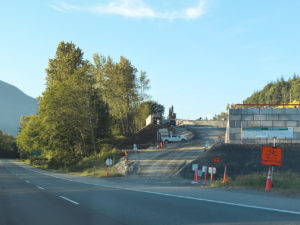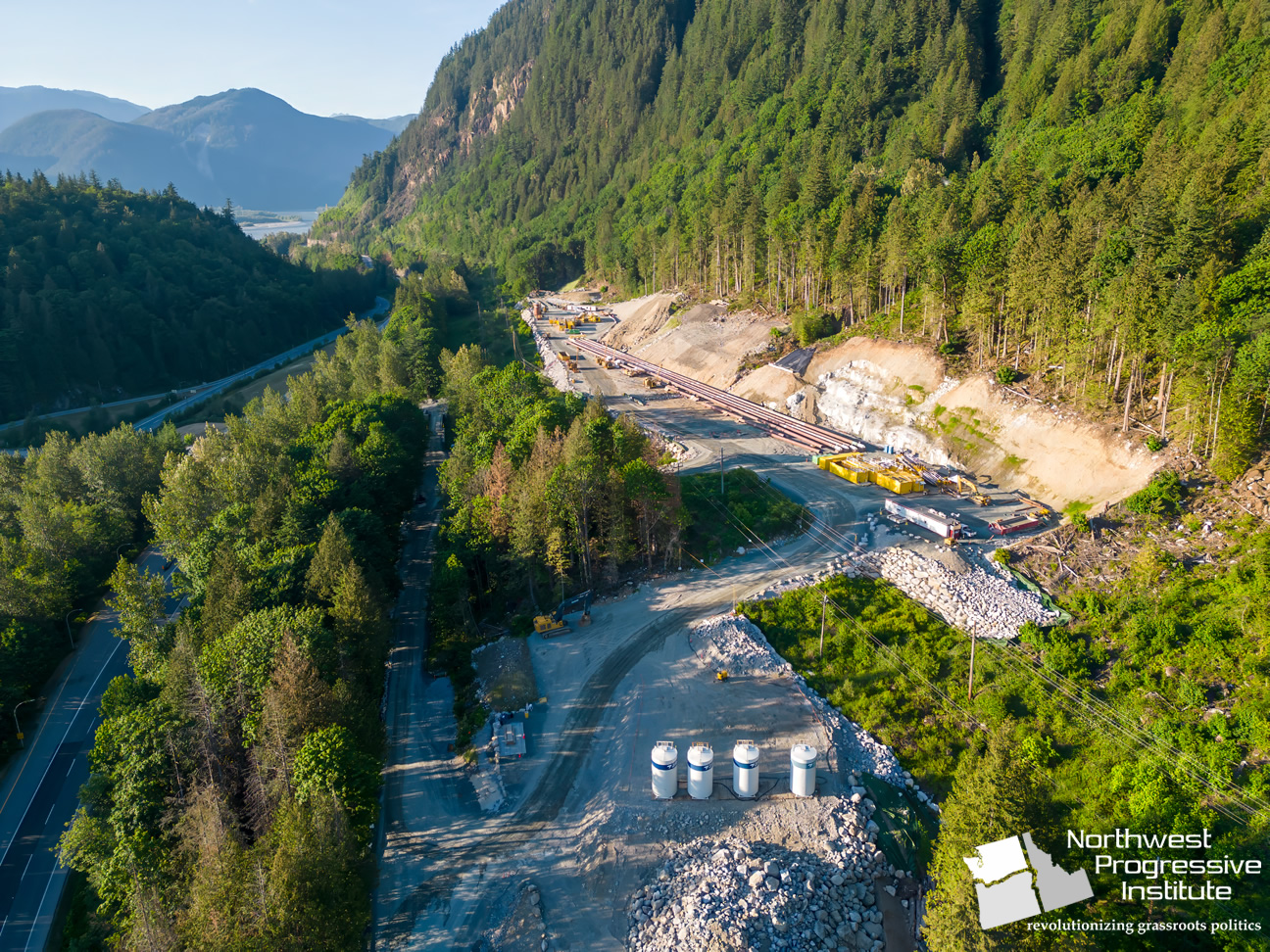Befitting its nickname of “the Great White North,” Canada has long been addicted to megaprojects: huge hydroelectric developments in northern Quebec, oilfields in Alberta, offshore drilling in rough waters near Newfoundland, plus petro pipelines.
A mega-pipeline is currently under construction in British Columbia, which will have potential impacts on both sides of the 49th Parallel. The 1,150-kilometer TransMountain pipeline expansion will carry oil from Edmonton, Alberta through British Columbia to tankers in Burnaby, just east of Vancouver. The project will triple pipeline capacity from 300,000 barrels a day to 890,000 barrels.
The pipeline route plows through Jasper National Park and Mount Robson Provincial Park, heads south down the Thompson River and Coquihalla Rivers and eventually through the Fraser River valley into B.C.’s populous Lower Mainland.
Andrew Villeneuve, NPI’s founder, witnessed the construction while enroute to the Canadian Rockies earlier this month, and delivered this observation:

“All along the highways of lower British Columbia is evidence of TransMountain Pipeline construction. Felled trees, ugly bald hillsides, pipeline sections, rumbling trucks, gravel driveways, orange cones… The beauty of my June 12th trip from Chilliwack to Hope and then up to Merritt was spoiled by this ugliness and what it portends.”
What does it portend?
The oil is not for burning in British Columbia, Canada or the Northwest. It will be pumped onto tankers and shipped mostly to Asia. The pipeline will mean a seven-fold increase in tanker traffic in and out of the pipeline terminus.
While our founder received an eye-level view, I recently had an elevated perspective on potential pipeline impacts.

The view from Deer Park, in Olympic National Park, looks down a vertical mile to waters of the Salish Sea. The oil-laden tankers from TransMountain’s new oil port will head out through Burrard Inlet and English Bay, and down through Haro Strait: The strait is boundary between our San Juans Islands and Canada’s Gulf Islands. The ships would then exit out the Strait of Juan de Fuca.
The tankers will traverse the migration routes of great sockeye salmon runs that head up the Fraser River to spawn in the Adams, Quesne, and Stuart River systems. They will travel past both U.S. (Olympic) and Canadian (Pacific Rim and Gulf Islands) national parks, as well as national monuments, state parks and provincial parks. The Salish Sea is home to our critically endangered southern resident orca whales, as well a world-famous recreation destination.
Any oil spill, spread by powerful currents, would be catastrophic.
A 231,000-gallon bunker oil spill in December, 1988, off Ocean Shores, fouled beaches in Olympic National Park with currents carrying oil north to Long Beach in Pacific National Park. Aware of potential danger, both then‑B.C. Premier John Horgan and Governor Jay Inslee opposed TransMountain.
But B.C.’s legal appeals were rebuffed by Canada’s Supreme Court.

The wider implications go far beyond sensitive marine waters of the Salish Sea. Consider these words from Environment and Climate Change Canada, an agency of the federal government: “Canada is warming at twice the global average rate and at three times the rate, in the north.”
Climate damage has literally come to the doorstep of Canada’s carbon economy. The main producer of bitumen crude oil carried by TransMountain is the “oil patch” near Fort McMurray. Northern Alberta has experienced droughts and heat waves in recent years, generating record wildfires.
A 1.5 million-acre fire in 2016 destroyed 2,400 houses and buildings, forcing 88,000 people in and near Fort McMurray to flee their homes, the largest evacuation in Canadian history. As of June 23rd, fires this year have consumed a half-million acres in the Fort McMurray forest area.
Global warming has intensified storms off the Earth’s oceans. A record flow of “atmospheric rivers” came ashore off the Pacific Ocean in November of 2021, and traveled the route Andrew took this month. The lower Fraser Valley was isolated. The Coquihalla highway was ruptured near Merritt. And for a time, Greater Vancouver was cut off by land from the rest of Canada.

In words of Marc Lee, senior economist with the Canadian Center for Policy Alternatives, “TMX would facilitate about 84 million (metric) tonnes per year of CO2 emissions (upstream and exported). At $200 per tonne, that’s $16.8 billion (Canadian) annually in future damages, meaning by every year TMX is in service, it could deliver a blow roughly equivalent to the $17 billion in damage B.C. experienced in 2021 due to extreme weather.
“The 84 million tonnes is substantially larger than B.C.’s current greenhouse gas emissions and equivalent to 11 percent of Canada’s annual emissions.”
“The catch? Most of those emissions will be in other countries, not connected in Canada’s greenhouse gas inventory.”
Prime Minister Justin Trudeau is implementing a controversial pollution tax, and has committed to developing what he calls a low carbon economy for Canada.
At the same time, Trudeau is the chief political architect of TransMountain expansion. The Canadian government paid $4.5 billion CAD (CAD = Canadian Dollars) to purchase the pipeline in 2018 from Kinder Morgan when the Houston-based firm was threatening to pull the plug on the project. The expansion was once projected to cost $7 billion CAD to complete, but cost estimates soared to $21.9 billion CAD in 2022 and have now reached $30 billion CAD.
As sadly often happens around the globe, near-term political and geopolitical considerations have taken precedent over protecting the Earth.
The current prime minister and his father, the late Prime Minister Pierre Trudeau, have never been popular in Western Canada. The governing Liberal Party holds only two seats from Alberta in Canada’s House of Commons in Ottawa.
TransMountain will guarantee a global market for Canadian oil, particularly now that American Presidents Obama and Biden have forced the cancellation of the Keystone XL Pipeline. Hence, the project has been deemed in “Canada’s interests” despite its environmental impacts and climate costs.

The pipeline project is a holy grail in Alberta, the Wildrose province, whose then-premier threatened the B.C. government with trade retaliation.
Trudeau has previously argued that the pipeline generates jobs, and that profits from TransMountain will help pay for Canada’s transition to a green, low pollution economy. Yet, a report published only a few days ago by the Parliamentary Budget Officer said the Canadian government’s 2018 decision “to acquire, expand, operate, and eventually divest of the TransMountain assets will result in a net loss for the federal government.” The bottom line: “TransMountain no longer continues to be a profitable undertaking.”
In pre-Pleistocene times, giant woolly Mammoths roamed the Great White North, but were rendered extinct by changes to the climate and hunting by early humans. With the TransMountain expansion, today’s Canadian government may bring into being a new species of white elephant.


The toxic bitumen has to be stopped at the BC/AB border. Google and read, “Kalamazoo River oil spill — Wikipedia.” What happened to the Kalamazoo River, we cannot let happen to the Fraser River. A toxic bitumen spill into the Fraser River will kill most of BC’s sport and commercial salmon industries.